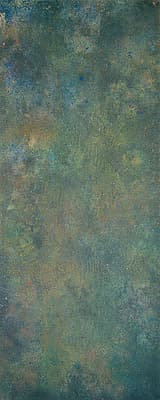
Natvar
BHAVSAR
India
1934
to United States of America 1962
SHA-DHA
1970
dry pigment and synthetic polymer paint on canvas
signed and dated verso c.r., synthetic polymer paint, "Natvar Bhavsar/ Nove 70"
275.5 (h)
x 120.0 (w)
cm
Purchased 1981
National Gallery of Australia, Canberra
NGA 1981.3046
- the artist;
- from whom bought by the Australian National Gallery, March 1981
- Natvar Bhavsar
- Max Hutchinson Gallery 03 Apr 1971 – 24 Apr 1971
- Abstract Expressionism: the National Gallery of Australia celebrates the centenaries of Jackson Pollock and Morris Louis
- 14 Jul 2012 – 24 Feb 2013
- Michael Lloyd and Michael Desmond, European and American paintings and sculptures 1870–1970 in the Australian National Gallery, Canberra: Australian National Gallery 1992, pp. 406–07, col. illus.;
- Irving Sandler, Natvar Bhavsar: Painting and the reality of color, Sydney: Craftsman House 1998, pp. 30–31, col. illus. pl. 2
Bhavsar’s paintings from the late 1960s draw on precedents set by Mark Rothko, Ray Parker and colour field painters such as Morris Louis and Jules Olitski. In his unique and complex transfer technique, however, Bhavsar expands on the territory of other colour field painters. For SHA–DHA 1970 and E–JNA 1970 he used prepared pigments and worked on a sheet of linoleum on the floor. A canvas, primed with acrylic medium and attached to a temporary support, was pressed down onto the surface of the linoleum transferring the pigments. The canvas was then stretched and the paint surface sprayed with an acrylic varnish to saturate and stabilize it.[1] This technique, which is akin to the monotype process, results in works which are visually striking and startlingly tactile.
The artist credits aspects of this, and his later technique of using a screen to disperse pigment,[2] to his Indian heritage:
In India, there is an old tradition that for each holiday, people create color decorations. You take color into a pouch and pour it through a screen onto the ground. When I was only twenty, the secretary of a college student group asked me if I would participate in a school celebration by creating a decoration in the hall on the floor. I did a very large painting, 80' long and 10' to 15' wide. So I have been working in that method since my childhood.[3]
Writing specifically of SHA–DHA 1970 and E–JNA, Bhavsar explains that his titles are non-referential and without any particular meaning:
I choose titles for my paintings largely from ancient Sanskrit terminology. They often refer to either musical compositions, past events, places of historical reference, etc., even nature. These two particular titles are only selected for their sound. My paintings are totally abstract, and I prefer not to have the viewer led by the suggestion of the title. The paintings were painted with dry pigments with many, many layers on canvas saturated with acrylic medium.[4]
Bhavsar sees his works as vehicles for spiritual expression, and seeks colour that is simultaneously visual and physical. He contests the validity of Clement Greenberg’s formalist distinction between ‘opticality’ and ‘tactility’ as defining two different fields, namely, painting and sculpture respectively.[5]
Michael Lloyd and Michael Desmond, European and American paintings and sculptures 1870–1970 in the Australian National Gallery, Canberra: Australian National Gallery 1992, p. 406, revised Steven Tonkin 2003 and Lucina Ward 2012
[1]Natvar Bhavsar, discussion with National Gallery Conservator David Wise, by telephone, June 2012.
[2] Bhavsar subsequently adapted this technique to disperse dry pigments onto a prepared canvas using a screen. The process of sifting the pigment was repeated as many as 80 times for a single work. He used different pigments and adjusted the distance between screen and canvas so the substance was distributed across the canvas with varying densities of colour.
[3] Cynthia Goodman, ‘Interview with Natvar Bhavsar’, Arts Magazine vol. 55 no. 6, February 1977, p. 13
[4] Natvar Bhavsar, correspondence of 23 September 1987 with the National Gallery of Australia, NGA file 70/3018.
[5] see Irving Sandler, Natvar Bhavsar: Painting and the reality of color, Sydney: Craftsman House 1998, pp. 14–16
The National Gallery of Australia also holds three works on paper: Aaru 1972 and two untitled screenprints.
